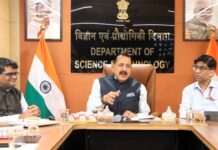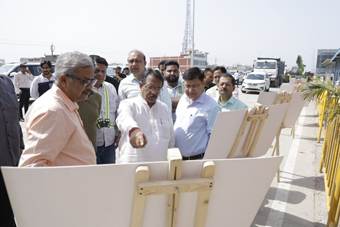MAY 17: Shri Harsh Malhotra, Union Minister of State for Road Transport and Highways and Corporate Affairs, conducted a comprehensive inspection of the 210-kilometer Delhi-Saharanpur-Dehradun Expressway today. The inspection, which included the Minister’s visit to various sections of the expressway along with National Highways Authority of India (NHAI) officials, underscored the government’s commitment to improving infrastructure and connectivity.
During the inspection, the Minister expressed his satisfaction with the ongoing progress and highlighted the strategic importance of the expressway in decongesting the National Capital Territory (NCT) of Delhi. He pointed out that once completed, the expressway will alleviate traffic pressure on the Delhi-Meerut Expressway and other connecting highways, providing much-needed relief to commuters.
Shri Malhotra also took note of the minor bottlenecks reported by NHAI officials and emphasized the importance of completing the project within the stipulated timeframe. He directed the officials to expedite work in the remaining sections, ensuring that the expressway is opened for public use as planned.
The Delhi-Dehradun Expressway, which starts from Akshardham Temple in Delhi and extends to Dehradun, will pass through key towns in Uttar Pradesh, including Baghpat, Baraut, Muzaffarnagar, Shamli, and Saharanpur, before culminating in Dehradun. The project is being developed at an estimated cost of Rs. 12,000 crore and is designed to improve connectivity while significantly reducing travel time.
Once operational, the expressway will cut down the travel time between Delhi and Dehradun from the current 6.5 hours to just 2.5 hours, providing a seamless and faster route. The expressway will also feature a spur leading to Haridwar and will connect to the Char Dhaam Highway, enhancing access to key pilgrimage sites and hill stations in Uttarakhand and Uttar Pradesh.
In addition to its strategic and economic benefits, the expressway development has also made significant strides in environmental conservation. As part of the project, Asia’s longest elevated corridor—spanning 12 kilometers—has been constructed within Rajaji National Park, ensuring the protection of wildlife and the natural ecosystem.
The expressway’s rapid progress is a testament to the Modi government’s commitment to enhancing national infrastructure and ensuring smoother, faster, and safer travel across critical corridors in the country. With just 2-3 months remaining for completion, the Delhi-Saharanpur-Dehradun Expressway is set to become a game-changer in the region’s connectivity.



















